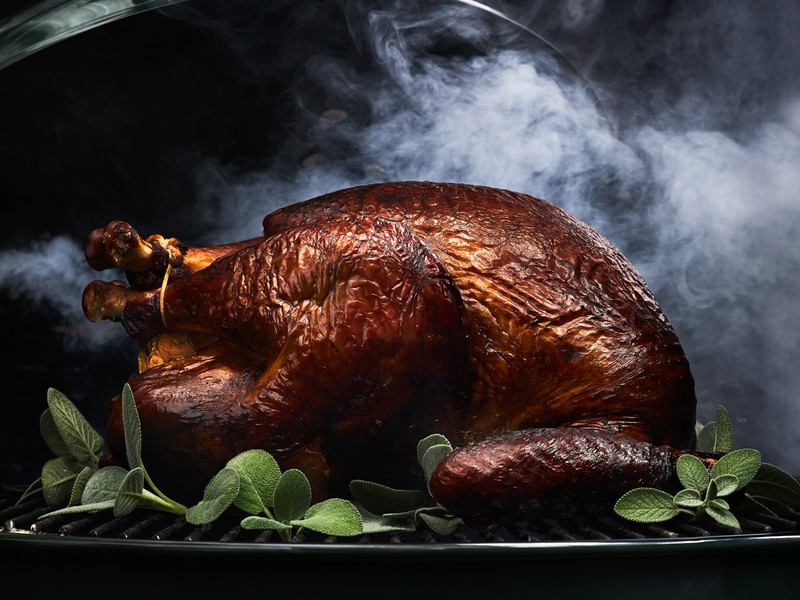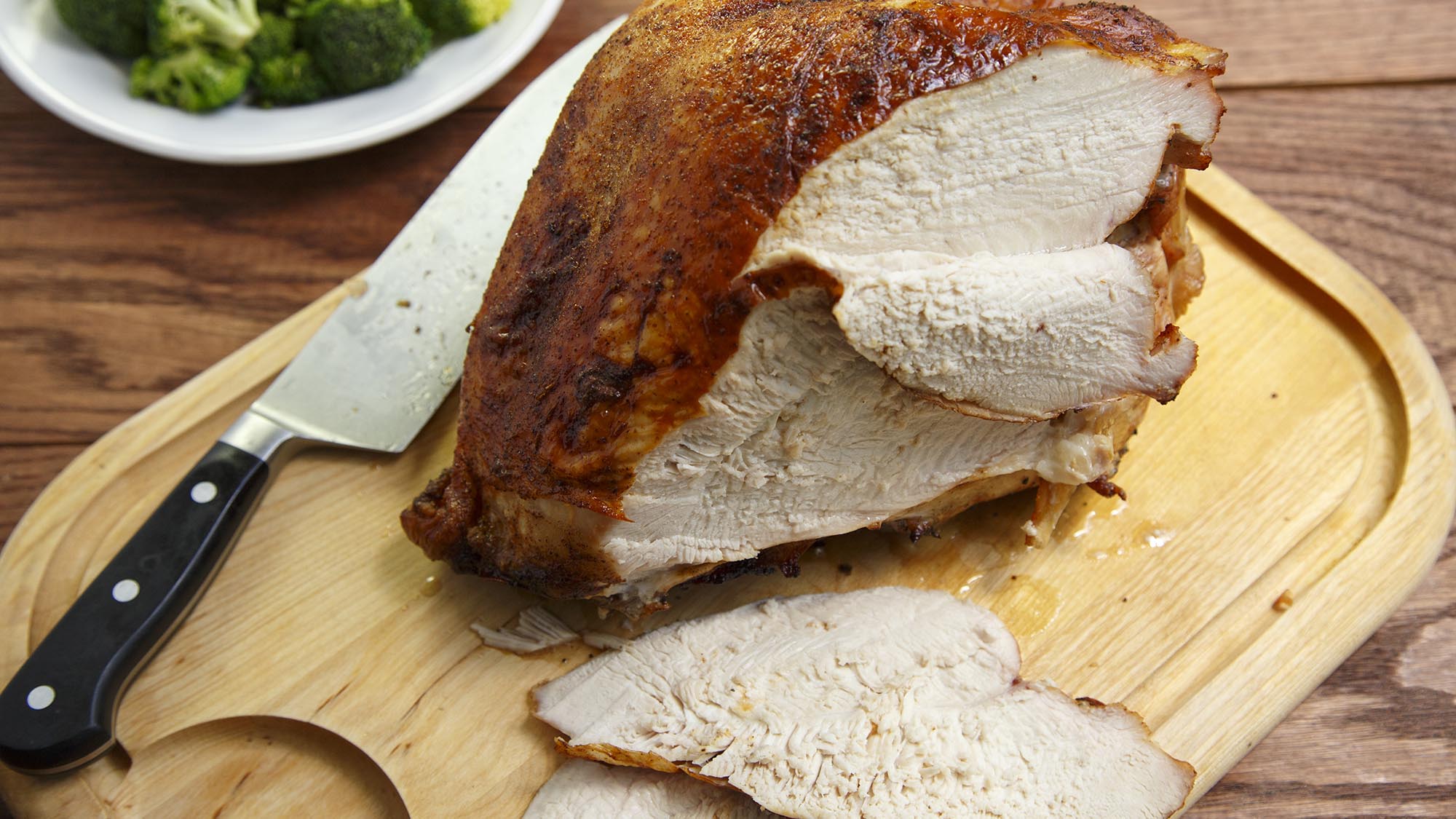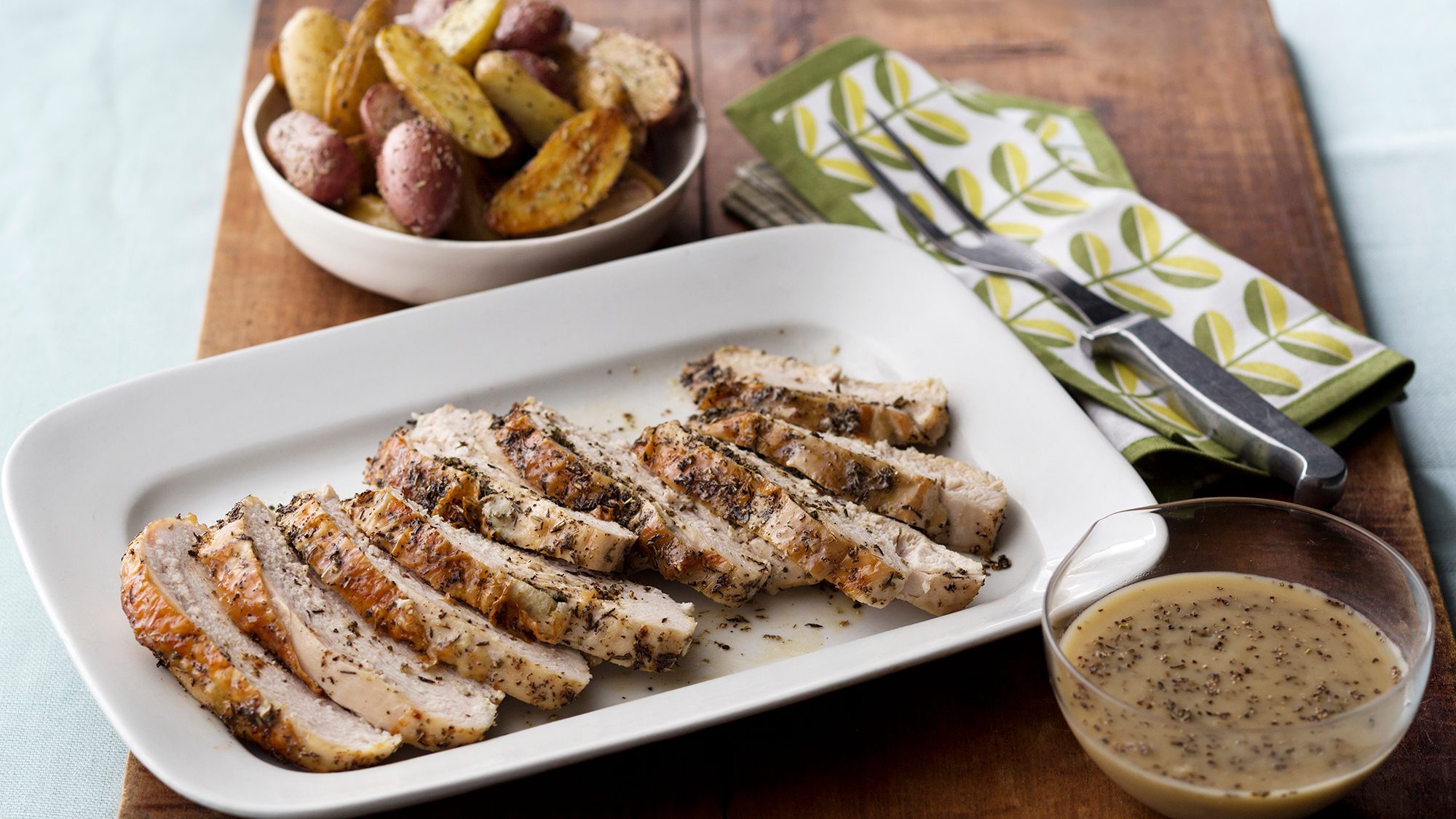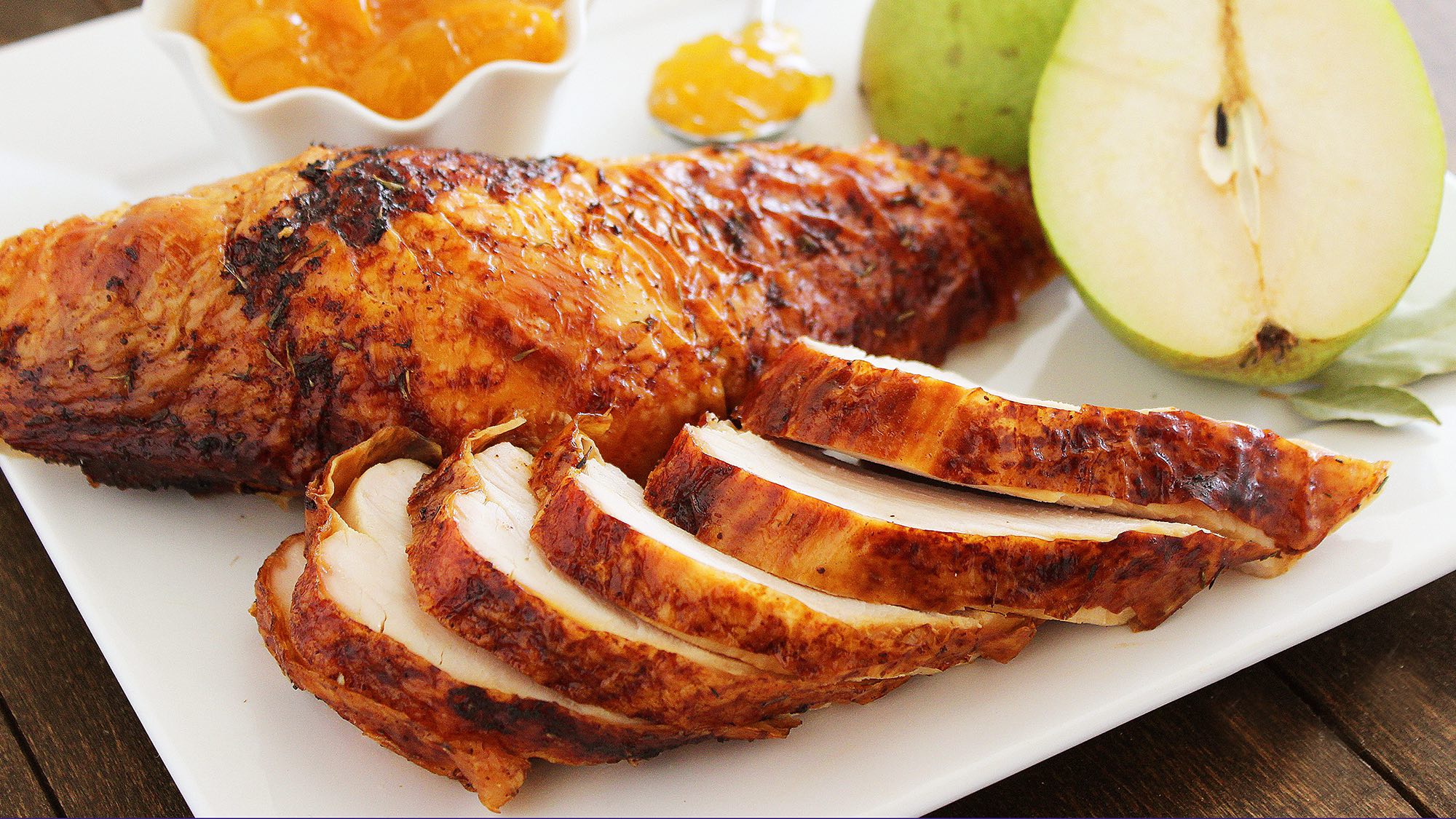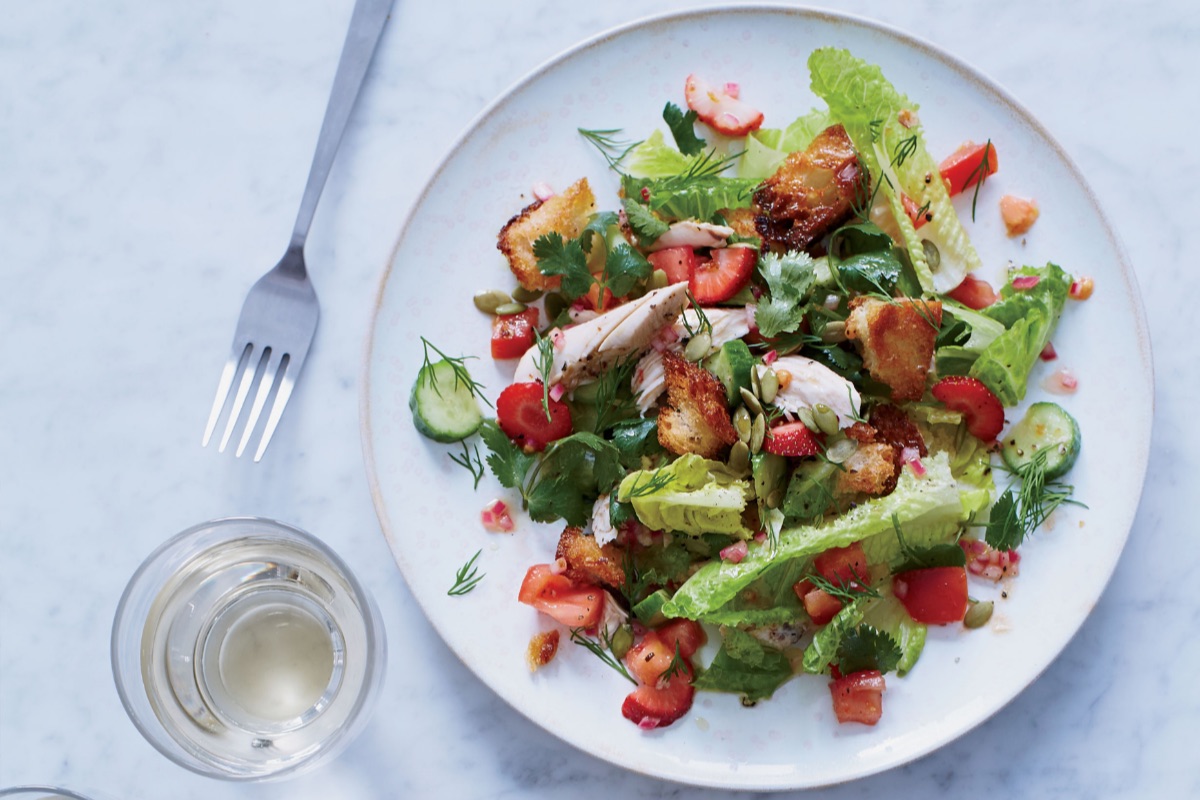Smoking is a great way to cook a turkey for a few reasons. It frees up the oven for Thanksgiving side dishes and pies. It gives the cook—and their guests—a good reason to hang out outside, around the fire, for the better part of the day. And most of all, smoking turkey at home can give you the perfect Thanksgiving centerpiece: a turkey with gorgeous, lacquered skin and flavorful, juicy meat.
Plan on smoking the turkey for 12-15 minutes per pound for a small (12- to 14-pound) turkey. A small turkey is best, so the bird can sit away from the coals, and cook from the indirect heat and smoke adjacent to the coals versus grilling directly over them.
If you have a backyard smoker, the process is pretty straightforward, but you can also make a Simple Smoked Turkey on a kettle grill, using the lid and the vents to regulate the flow of air in the grill.
Get a remote probe thermometer
Before you get started, if your kettle grill does not have a built-in thermometer in the lid, invest in a remote probe thermometer. You absolutely need one to smoke a turkey on a kettle grill. And you won’t regret it—a good probe thermometer is super versatile. It can be used as a candy thermometer (use a binder clip to hold it to the side of a saucepan), and also in your regular oven.
Clean out your grill before starting
For our method, we used a standard-sized Weber kettle grill, which is 22-inches in diameter. Begin by making sure that the bottom vent is open, and that you clean it out completely, removing any ashes from the bottom of the grill, so that air flows easily through the bottom vent. Keep the bottom vent open for the duration of your turkey-smoking—you will open and close the top vent, the one in the lid, to regulate air flow as the turkey smokes.
Photo: McCormick
Create a cool zone for the turkey
Place a disposable aluminum drip pan (such as this one from Reynolds) with 1 inch of water in it on top of the coal grate, all the way to one side of the grill. The pan should cover about 2/3 of the bottom of the grill. You will ultimately place the bird on the grill grate above the pan, away from the direct heat radiating of the coals. The pan will catch any drippings (helping to avoid flare-ups and making cleanup easier) and the water in the pan will help to moderate the heat in the smoker.
Dry the bird completely
In order to absorb smoke well, the surface of the turkey needs to be as dry as possible.
If you are wet-brining the turkey first, remove it from the brine and pat it dry with paper towels, and leave it out to take the chill off while you start the coals. Pat it completely dry again and stuff a paper towel in the cavity just before you put it on the grill.
Remember: the turkey can’t be too dry. For best results, air dry it in the fridge, overnight, if you have the time.
Photo: McCormick
Use the right fuel
When smoking a turkey on the grill, you will use two kinds of fuel: charcoal (which will provide the heat) and wood (which will provide the smoke).
For your coals, use untreated charcoal briquettes, which work better for smoking than lump charcoal. Briquettes are made from tightly packed powdered charcoal and other ingredients (like coal, and binders that help hold the briquettes together), and are denser than lump charcoal (which is wood that has been burned and was snuffed out). Briquettes burn longer than lump charcoal, which is what you want for smoking. Make very sure the briquettes aren’t treated with lighter fluid or fire starter, such as those labeled “match light.” (You don’t want those chemicals anywhere near your food). We like Kingsford Long Burn Charcoal.
Light the briquettes using a chimney starter. (OK, you can also ignite your briquettes with loads of newspaper and fussing, but a chimney starter makes it much easier, and eliminates the need for lighter fluid.)
When the coals are fully lit with orange flames shooting out, put them in the grill to the side of the aluminum pan. Use a set of long tongs or a wok spatula, like this one to bank the coals, so they are heaped to form a slope against the side of the grill, with the higher side of the slope against the wall of the grill furthest from the aluminum pan. The coals should cover about 1/3 of the bottom of the grill.
Wood chunks will provide the smoke for your grill-smoked turkey. Soak them well in water, then place them on the lit coals in the grill, so that they smoke rather than burn. (If you’re following our recipe for brined smoked turkey, go ahead and soak the wood chunks in water while the turkey brines.)
What kind of wood is best for smoking? You can use everything from a cord of oak wood from the grocery store broken down into chunks with a hatchet to store-bought wood chunks, such as apple wood chunks from Weber. (If you can only find wood chips, you use those as well. You will still need to soak them, and because they will burn more quickly, you will need to replace them periodically.)
Photo: McCormick
Learn to control the temperature
The hardest part of smoking a turkey on a kettle grill is learning to control the ambient temperature inside the grill. If your grill has a temperature sensor in the lid, that helps to keep an eye on things. If not, use a probe thermometer.
A kettle grill doesn’t come with a temperature control, so what do you do? You use the top vent—the one in the lid—to increase or restrict air flow through the grill.
Before putting the turkey on to smoke, put the top lid on the grill so that the top vent is positioned on the opposite side of where the coals are banked. (The top vent holes should be over the aluminum pan.) Open the holes of the vent in the lid all the way. If your grill doesn’t have a thermometer in the lid, stick the probe thermometer sensor through the vent, so it reads the ambient air temperature.
The ambient temperature inside the grill should be hot at first, around 450-500. Close the top vent. The temperature will drop as the coals are denied oxygen. Get the temperature to 300-325, and then adjust the top vent to hold the temperature in that range. Continue to monitor the temperature and make adjustments (opening that top vent to raise the temperature, and closing it to lower the temperature) to keep it in that range for 5-10 minutes.
Photo: McCormick
Keep the turkey off the coals
Tie the legs and position the turkey, breast up, on the grill above the pan of water, so that the leg are pointing towards coals, where it’s hottest. This way the legs are more exposed to the higher temperatures, while the lean breast meat is further from the more intense heat. No part of the turkey should be directly over the coals. (If your turkey is too big to fit on the grill this way, position it sideways, and turn it occasionally as it smokes).
If there’s a plastic doneness indicator in the turkey, remove it.
If your probe thermometer has two probes, stick one in the turkey’s hip, between the thigh and the breast. (Be sure it’s not touching the bone.)
Then replace the lid, so that the vent is at the head of the turkey, on the opposite side of the grill from where the coals are.
The temperature will drop when you replace the lid, but leave the vents where they are. If you notice the temperature is still dropping after an hour, take the lid off and drop 10 unlit coals onto the lit coals in the grill, and open the top vent to help start them.
Check in—but not too often
Our kettle grill smoked turkey calls for brushing the turkey with vinegar every 25 minutes. When you remove the lid to baste the bird, check on the coals. You don’t want them to dissolve into a pile of ash, so if they seem to need replenishing, add 10 unlit coals into the grill, and open the vents a bit to help ignite them.
If the bird seems to be browning unevenly, rotate it on the grill every 45 minutes or so. The bird is done with it reaches an internal temperature of 155 F at thickest part of the breast.
Nail the Dismount
To remove the turkey from the grill, our Senior Food Editor Mary-Frances Heck recommends shoving a pair of long tongs or a long-handled metal spoon into the cavity with one hand, and using the biggest spatula you have to lift from underneath the turkey. To keep the skin looking beautiful, try not to touch it. Transfer your smoked turkey to a cutting board with a juice groove to catch drippings, or transfer it to a cutting board set inside rimmed baking sheet.
Tent the bird loosely with foil and let it rest at least 30 minutes before carving.
This article was written by Liz Mervosh from Food & Wine and was legally licensed through the NewsCred publisher network. Please direct all licensing questions to legal@newscred.com.



